The Liturgy of the Oblation performed before the Divine Liturgy, known as the Proskomide, prepares the offering of bread and wine on the Table of Oblation, which is called the Prothesis. The word “Proskomide” comes from the Greek word proskomizo, meaning “to bring” or “to offer.” The Divine Liturgy can not be celebrated without the Proskomide.
Originally in the East, people deposited their offerings of bread and wine at the front of the church on their way inside. In the Hagia Sophia, the Imperial church of Constantinople, these gifts were prepared by the deacons in a small round building called the skevophylakion at the north-east corner of the church. The deacons initially did everything: they received the gifts, sorted them, prepared them, finally bringing them into the church and up to the altar at the Great Entrance. The performance of the Proskomide by the deacon -- and not the priest -- was continued until the fourteenth century. The preparation of the gifts became a full blown rite around the time of Saint Maximus the Confessor in the early seventh century. By the time of Saint Germanus in the eighth century, the Proskomide had acquired a definite symbolic significance.
The reason for offering the gifts during the Proskomide is to give thanks to God and to make supplication to Him. The Proskomide service is ministered on the Prothesis, a table built into the wall of the apse. The Prothesis is situated on the left side as one faces the Iconostasis from the nave. The apse of the Prothesis symbolizes the manger.
The bread which is to be changed into Christ’s Body is separated from the rest of the loaves by the priest, who places it on the holy Diskos (paten) and consecrates it (sets it apart) to God. He then carries it to the altar and offers it up. This round loaf of bread, which is made of pure wheat, is called the prosphora (the “offering” or “gift”) and is stamped on the top with a special seal (called the Sphragis or Panagiari). The bread must also be leavened, leaven symbolizing our participation in the person of Jesus Christ, the Word of God who became man. The Orthodox also see leaven as manifesting the Church as the Body of Christ, which only exists insofar as it participates in the leavened eucharistic Body of Christ. This recalls what Jesus said: “The kingdom of heaven is like leaven.”43 The Orthodox Church tends to see unleavened bread as a symbolic relapsing into the Old Covenant, denying the Incarnation and consequently the salvific grace of the Gospel.44
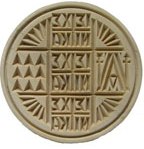
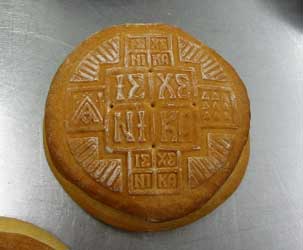
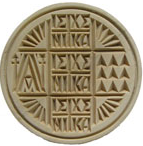
The Prothesis signifies the place of Calvary, where Jesus was “offered up” to God. Calvary was prefigured in the Old Testament by Abraham when God commanded him to make an altar of stone on a mountain, collect wood, and sacrifice his son on it. In his mercy, though, God allowed a ram to be offered instead. This was to show that the Father was pleased to allow, in “the fullness of time,”45 His eternal Son to be incarnate of the pure virgin Theotokos and to be sacrificed for our sins. Though in His divinity He remained impassible (not subject to pain), nevertheless, as a man Christ suffered all His torments to the fullest -- and gladly because of His immense love for us.
The Discos on which the bread is placed, according to the eighth century Patriarch of Constantinople, Saint Germanus, “represents the hands of Joseph of Arimathea and Nicodemus, who buried Christ. The Discos on which Christ is carried is also interpreted as the sphere of heaven, manifesting to us in miniature the spiritual sun, Christ, and containing Him visibly in the bread. The Chalice corresponds to the vessel which received the mixture [of water and blood] which poured from the bloodied, undefiled side and from the hands and feet of Christ. Or again, the Chalice corresponds to the bowl which the Lord depicts, that is, Wisdom; because the Son of God has mixed His blood for drinking instead of wine, and set forth on His holy table, saying to all: `Drink of my blood mixed for you for the remission of sins and eternal life.’”46
The cover on the Discos represents the cloth which covered Christ's face in the tomb. The veil, or the aer, is a rectangular ornamented veil for covering both the Chalice and Diskos after the Proskomide. The aer corresponds to the stone which Joseph placed over the entrance of the tomb and which Pilate’s guards then sealed. It can also represent the shroud which contained the Lord’s body.
Christ assumed the entirety of our human nature, except for sin.47 The bread which is offered in the Liturgy signifies the super-abundant goodness of our God, who became man and gave Himself as an offering for the life of the world. Jesus Himself made this connection between His Incarnation and bread when He identified Himself as the manna which God sent to the Israelites in the desert: “I am the bread which came down from heaven,” He said in the sixth chapter of the Gospel of John. “He who eats this bread will live for ever.”48
The priest and the deacon reverence the
Prothesis, and then the priest removes the red cover from the Chalice and
the Diskos, laying it to one side. As he does so, he says: “Make ready, O
Bethlehem, for Eden has been opened for all. Prepare, Ephratha, for the tree
of life has blossomed forth in the cave from the Virgin; her womb became a
spiritual Paradise in which is planted the divine Plant. For in
eating from the Plant we will live, and not die as did Adam. Christ will be
born to raise the image that fell of old.”
Everything now being prepared, the priest then says: “You have redeemed us from the curse of the Law,49 by Your precious Blood; being nailed to the cross and pierced with the spear, You have poured forth immortality upon humanity: Our Savior, glory to You.” Holding the offering with both hands, the priest elevates it and makes the sign of the cross with it over the Chalice and Diskos, saying: “Blessed is our God, always, now and ever, and to the ages of ages.”
.jpg)
The priest next picks up an instrument called the “spear” or the “lance.” This small metal knife which is designed to look like a spear was probably introduced sometime around the ninth century. Holding the loaf in his left hand and the spear in his right, the priest makes the sign of the cross with the spear three times over the loaf, saying each time: “In remembrance of our Lord and God and Savior Jesus Christ.” The priest thus recalls the Lord’s command, “Do this in remembrance of me.” This command applies not only to the gifts being consecrated, but to the Liturgy as a whole. We are to “do” the Liturgy “in remembrance” of all that Christ did to achieve our salvation, even those events (indeed, especially those events!) which seem to denote nothing but weakness: His Cross, His Passion, and His Death.
In the center of the bread is the square section which we described above as the “seal” stamped onto the prosphora. This is known as the “Lamb” because it is the part which shall be changed into the Body of Christ. On the Lamb is written “IC XC NIKA,” which is a Greek abbreviation meaning, “Jesus Christ Conquers.” This strange paradox of the “Lamb” which “conquers” recalls the vision of John in the Book of Revelation, where those who follow the beast “make war with the Lamb, and the Lamb will overcome them, for He is Lord of lords and King of kings; and those who are with Him are called chosen, and faithful”50
Taking the spear and cutting along the right edge of the Lamb (on the priest's left), the priest says, echoing the prophecy in Isaiah: “Like the Lamb that is led to the slaughter.”51 The lamb normally symbolizes, among other things, helplessness, innocence and gentleness. When the image of a lamb is used figuratively of a person, it arouses sympathy, concern, pity and compassion for that person. In the Old Testament, the lamb is a symbol of Israel and the Lord is called their Shepherd, as in Psalm 23. The lamb is also the sacrificial victim brought as an offering to God for the salvation of the Chosen People, and the blood of these offerings was used to cleanse the sanctuary in the Temple. In the Old Testament the sacrifice of a lamb is at the heart of the most important Jewish feast of all, the Passover. Indeed, all the major feasts of the Israelites call for the sacrifice of a lamb.
John the Baptist twice greets Jesus at the beginning of the Gospel of John with the title, “the Lamb of God.” At the end of the same gospel, Jesus is crucified on the afternoon before the Feast of Passover began, while the Passover lambs were slain.52 Jesus is the Lamb of the New Passover, through Whom we “pass over” from death to life. In heaven at the right hand of the Father, our Lord still bears the wounds of His Passion, by which He triumphed over sin and death.
Cutting along the left edge of the Lamb, the priest says, citing Isaiah 53:7 from the Greek Septuagint: “And like a blameless sheep that before its shearer is silent, so He did not open His mouth.” Cutting along the upper edge of the Lamb, the priest cites the next verse in Isaiah: “In His humiliation right judgment was denied Him.”53
Cutting along the lower edge of the Lamb, the priest continues reciting Isaiah 53:8: “Who could have told His posterity?” This cutting of the loaf is done for practical reasons, so that the Host may be removed. It has a symbolic value also -- it represents our Lord's passing from the world to His Father, as He Himself said, “I leave the world, and go to the Father.”54
Piercing the bread at the right corner of the seal and cutting away the bottom crust, the priest removes the Lamb from the loaf and finishes citing Isaiah 53:8: “For His life is taken up from the earth.”
The priest turns the Lamb over on the Diskos, placing the face of the seal downward. He then makes a deep cross-wise cut on the back of the Lamb without cutting through it. As he does this, the priest repeats the words of John the Baptist: “The Lamb of God, who takes away the sin of the world,55 is sacrificed for the life of the world56 and its salvation.”
The priest then turns the Lamb over once more so that the seal is now upward. Inserting the spear in the right side of the section marked IC, the Greek initials for “Jesus,” the priest quotes the testimony of John the Theologian: “One of the soldiers pierced His side with a spear, and at once blood and water came out; and he who saw this has testified, and his testimony is true.”57 This incision in the bread made by the spear represents the wound in the Savior's side.
The wine and the water used in the Proskomide are the blood and the water which came forth, as we saw the apostle John testify to above. As the deacon pours the wine and water into the Chalice, the priest blesses the deacon with the sign of the cross: “Blessed is the union of Your Holy Gifts.”
Thus in the Proskomide the priest shows the Lord’s Passion, how He died, how His side was pierced with a lance, and how blood and water flowed from His side. The aim of all this is to link the Eucharist and the historical Jesus and to foreshadow the coming eucharistic sacrifice. Our communion with Jesus Christ can not be properly understood without also comprehending the doctrine of the communion of saints. The Apostle said to the Corinthians, “The cup of blessing that we bless, is it not a sharing in the blood of Christ? The bread that we break, is it not a sharing in the body of Christ? Because there is one bread, we who are many are one body, for we all partake of the one bread.”58 Thus the Liturgy is not only a Communio in Sacris, the Communion of the Holy Gifts, but is also a Communio Sanctorum, the communion of saints.
The Church is called the Body of Christ in the New Testament, so the priest cuts out pieces from the Lamb -- which will become the eucharistic Body of Christ -- to represent the whole Church, both those now living and those who are living with Christ in His kingdom, whom Saint Paul calls “the Church of the firstborn, who are written in heaven.”59 These pieces are placed on the Diskos around the Lamb, showing that Christ is the center of the Church. In this way, along with the Eucharist, we are mystically presenting ourselves to God as “a living sacrifice, holy, acceptable to God.”60
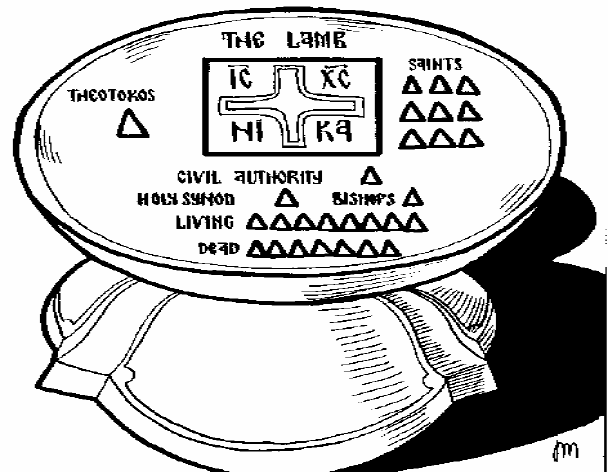
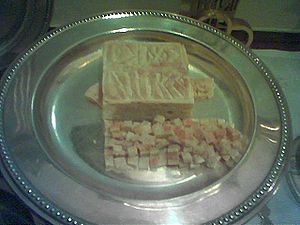
The first piece the priest cuts out represents the Theotokos. The Virgin Mary was put in a unique relationship to God on account of her role in the divine plan of salvation. From her the New Adam was born, and very often she is described in the Church as the new Eve, the new mother of the new humanity. Taking up the Lamb, the priest cuts from the left side of it a small triangular piece, saying: “In honor and memory of our most blessed and glorious Lady, Theotokos and ever-virgin Mary, through whose intercessions accept, OLord, this sacrifice upon Your most heavenly altar.” Lifting this piece, he places it on the Diskos to the right (his left) of the Lamb, saying, in imagery taken from the Psalms: “At Your right hand the queen stood, clothed in a robe of gold, arrayed in varied colors.”61
Then the priest takes nine pieces and puts them on the left side of the Lamb in honor of the angels and saints. Although in some manuscripts of the Liturgy the angels are not always ranked according to the traditional nine orders, it later became customary to list them this way, in descending order of rank.
Taking up the Lamb, the priest cuts from it a small piece, the first of the nine, and he places it on the Diskos immediately to the left (his right) of the Lamb. He then says: “In honor and memory of the great angelic leaders Michael and Gabriel and of all the bodiless powers of heaven.”
The second of the nine pieces is dedicated to the saints of the Old Testament. These saints are also saints of the Church, for they anticipated Jesus. Indeed, all of them in some way foretold the coming of the Messiah in their prophecies. The saints of the Old Covenant knew Christ because He revealed Himself to them and they in turn believed in Him. The new Christian saints in this regard are simply a continuation of the line of saints from the Old Testament, there being a unity to the divine plan throughout both the Old and New Covenants. Taking the second piece, the priest places it on the Diskos below the first piece, saying: “Of the honorable, glorious Prophet, Forerunner and Baptist John; of the holy glorious prophets Moses and Aaron, Elijah and Elisha, David and Jesse; of the Three Holy Children, Daniel the Prophet and of all the holy prophets;” The third piece is dedicated to the apostles, who were the actual followers and witnesses of Jesus. Paul wrote that the Church is “built upon the foundation of the apostles and prophets, Jesus Christ himself being the chief corner stone.”62 The Church is said to be “apostolic” because the Faith which was once and for all delivered to the apostles63 continues in their successors, those bishops who can trace their succession back to the apostles, thus keeping the Church in the apostolic Faith.
Taking a third piece, the priest places it on the Diskos below the second, saying: “Of the holy, glorious and all-laudable apostles Peter and Paul; of the Twelve, the Seventy and all the holy apostles and equals-to-the-apostles.”
The fourth piece is dedicated to the great Fathers of the Church, who were like heavenly stars upon the earth. The Fathers are those bishops and Christian writers of the first centuries who either had direct contact with the apostles or who were able through the Holy Spirit to express in a particularly compelling manner the apostolic Faith for the Church. Through them, God guided the Church in the true Faith, protecting the Body of Christ from dangerous heresies. Taking the fourth piece, the priest places it on the Diskos next to the first, saying: “Of our fathers among the saints, great hierarchs and universal teachers Basil the Great, Gregory the Theologian and John Chrysostom; Athanasius, Cyril and John the Merciful, patriarchs of Alexandria; of Nicholas of Myra; Spyridon of Trimythous; and Nectarius of Pentapolis and of all the holy hierarchs.”
The fifth piece is dedicated to the martyrs
who, out of love, willingly offered themselves as sacrifices. A martyr’s
death is a victory, the victory of a love which is stronger than death. As
Solomon wrote in the Song of Songs, “For love is as strong as death . . .
its flames are flames of fire, a most vehement flame.”64
The martyr loves his Lord with a love which consumes even suffering in its
flames; a love which burns vehemently to the point of sacrificial death,
when the victory of love over hatred is complete. Taking a fifth
piece, the priest places it on the Diskos below the fourth, saying: “Of the
holy protomartyr and archdeacon Stephen; of the holy, glorious great
martyrs, George the victorious, Demetrius the myrrh-streaming, Theodore the
Soldier and Theodore the General; of the hieromartyrs, Polycarp, Ignatius
the God-bearer of Antioch, Haralampus and Eleftherius; of the holy women
martyrs, Thekla, Barbara, Anastasia, Katherine, Kyriaki, Photeini, Marina,
Paraskeva and Irene and of all the holy hieromartyrs, right-victorious
martyrs and confessors.”
The sixth piece is dedicated to the ascetics who, in the words of the
Apostle, “Put on the whole armor of God...and wrestled not against flesh and
blood, but against principalities, against powers, against the rulers of the
darkness of this age.”65
Unless of our own free will we imitate Christ's Passion, living and dying as
our Lord did, His life is not in us.66
The ascetics have the same attitude as did Paul, who wrote, “I now rejoice
in my sufferings for you, and fill up in my flesh what is lacking in the
afflictions of Christ, for the sake of His Body, which is the Church.”67
Taking a sixth piece, the priest places it on the Diskos below the fifth, saying: “Of our venerable and God-bearing fathers who shone in the ascetic life, Anthony the Great, Euthymius, Paisius, Sabbas the Sanctified, Theodosius the head of monasteries, Onouphrius, Athanasius and Peter of Athos, and of all venerable men and women.”
The seventh piece is dedicated to the healers of the Church. They were always moved by compassion and ready to act, casting out spirits and curing the sick. God's acts of healing are victories over fallen human nature and over all evil spirits. In essence, by giving us a foretaste of when sickness and death will be finally overcome at the general resurrection, the gift of healing heralds the ultimate establishment of the kingdom of heaven. Taking the seventh piece, the priest places it on the Diskos next to the fourth, saying: “Of the holy, glorious Cosmas and Damian who performed cures without taking payment, Cyrus and John, Panteleimon and Hermolaos and of all the holy, selfless healers.”
The eighth piece is dedicated to the ancestors of God, Joachim and Anna (the parents of the Theotokos), for Mary’s purity and holiness are a testimony to her upbringing. She who gave birth to Christ was embellished with all virtues through their parenting. Consequently the Mother of God, while remaining a part of God’s Creation, was chosen by God to be raised above every creature. The eighth piece is also dedicated to Joseph the Betrothed, who was the virtuous guardian of Mary’s virginity, and to Simeon the God-receiver, who awaited the coming of God in the flesh.68 It is dedicated as well to the patron saint of the local church and to the rest of the saints. Taking the eighth piece, the priest places it on the Diskos below the seventh, saying: “Of the holy and righteous ancestors of God, Joachim and Anna; (of Joseph the Betrothed and Simeon the God-receiver); of (Name of the saint of the day), whose memory we celebrate this day; of (Name of patron saint of church) and of all the saints, at whose supplications, visit us, O God, and grant all of our petitions which are for salvation and life eternal.”
The ninth piece is dedicated to the author of the Divine Liturgy, Saint John Chrysostom, who reposed in 409. Although some parts were added to the Liturgy after his falling asleep in the Lord, the preponderance of the Liturgy was either written or revised by him. John, who became the archbishop of Constantinople in 398, acquired his name Chrysostom (“Golden Mouth”) because of his eloquent preaching of the Gospel as a priest at Antioch. Taking the ninth piece, the priest places it on the Diskos below the eighth, saying: “Of our father among the saints (John Chrysostom,69archbishop of Constantinople).”70
Taking up the loaf, the priest commemorates the living, taking a piece for each person and placing them on the Diskos in a row, beneath the letters NIKA (meaning “conquers” in Greek) on the Lamb. As he does this, the priest prays: “Remember, O Master, Lover of humanity, every Orthodox bishop who rightly divides the word of Your truth;71 our metropolitan (or archbishop or bishop [Name]); the honorable presbytery, the deaconate in Christ and every priestly and monastic order (and our brethren and concelebrants, priests, [Names], and deacons, [Names]); and all our brotherhood whom You have called into Your communion, through Your tender compassion, O all-gracious Master.”
The priest then remembers the bishop(s) who ordained him, his sponsors in ordination (if living), as well as his confessor and others among the living. He places a piece for each on the Diskos, saying each time: “Remember, O Lord, Your servant, [Name].”
The kingdom has yet to be obtained by the living; they are still running the race, so their eternal lot is still unknown. The same doubt exists for those who have passed away without a certain hope of salvation; therefore, the Church prays for them as well. This is the counterpoint to the Church’s commemoration of the Lord’s death and of the departed saints who have obtained the fullness of salvation. The Church gives thanks for Christ's saving actions in the saints and intercedes on behalf of all those for whom salvation is uncertain. Taking up the Lamb, the priest commemorates the departed, cutting out a piece for each. Placing the pieces on the Diskos in a row, beneath the pieces of the living, he says: “Again we pray for the blessed memory and forgiveness of sins of all patriarchs, bishops, priests, deacons, monastics, and every priestly and monastic order; the blessed and ever-memorable founders and benefactors of this holy house, and the priests and deacons who have served therein; and our Orthodox fathers and mothers and brothers and sisters who have fallen asleep in Your communion in the hope of resurrection to eternal life, O Lord, Lover of humanity.”
The supplication which seeks the forgiveness of sins and the repose of souls comes last of all. It is in the very nature of gratitude to refrain from mentioning our needs until we have remembered what we have already received. We must always first give thanks to God and praise Him, thus setting His glory above our own desires. The priest then remembers, if they have reposed in the Lord, the bishop(s) who ordained him and his sponsors in ordination. He may also remember others who have departed, placing a piece for each on the Diskos, saying for each: “Remember, O Lord, Your servant, [Name].”
The deacon may now remember whom he will of the living and the departed, the priest taking a piece from the Lamb for each. The priest then removes one piece from the Lamb and places it on the Diskos with those of the living, saying: “Remember, O Lord, my unworthiness, and forgive my transgressions, both voluntary and involuntary.”
The priest then kisses the spear and puts it aside.72 Next, the priest blesses the censer, saying: “Blessed is our God, always, now and ever, and to the ages of ages. Incense we offer to You, O Christ our God, as a fragrant spiritual offering73 which You receive upon Your most heavenly altar and send down upon us in return the grace of Your all-holy Spirit.”
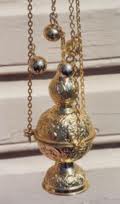
The censer symbolizes the humanity of Christ while the burning coal
represents His divinity. The interior of the censer is understood as the
sanctified womb of the holy virgin Theotokos who bore the divine coal, our
Lord and Savior Jesus Christ, in whom “the whole fullness of deity dwells
bodily.”74
Another way of looking at the censer is to see the interior as the baptismal
font which takes into itself the coal of the divine fire exuding the sweet
odor of salvation, the sweet operation of the Holy Spirit in Whom we receive
divine grace through faith.
In the first few centuries of the Church’s existence, Christian worship was devoid of incense because of its association with paganism and emperor worship. But as the memory of paganism receded, incense was eventually introduced into the Christian Liturgy, probably around the sixth century. Is this an example of a pagan infiltration into “biblical” Christianity, as some Protestant Fundamentalists contend? Quite the contrary! As paganism ceased being a threat to the Faith, people became more conscious that in the Bible incense was a regular part of Jewish worship. In fact, the word “incense” occurs some 124 times in the Old Testament alone. The Book of Exodus, for example, gives detailed instructions for an altar reserved exclusively for offering incense.75
The altar was square and made of acacia wood overlaid with gold and with golden horns at each corner. When the Temple was built, the altar of incense stood in the center of an area called the Holy Place before the veil hiding the Ark of the Covenant in the Holy of Holies.76 It was this same altar that the angel Gabriel stood next to when Zacharias, the father of John the Forerunner, went into the Temple to burn incense.77 The priest’s task was to place the incense on a heated coal on the altar and then prostrate himself in prayer. This was done each day early in the morning and at dusk. To do this was not granted to all priests, but only to those descended from Aaron, the elder brother of Moses. It also fell to Aaron, as the first high priest of Israel, on the Day of Atonement (Yom Kippur) to slay a bull as a sin offering in the Holy of Holies in the Tabernacle. Then, according to Leviticus, “he shall take a censer full of burning coals of fire from the altar before the Lord, with his hands full of sweet incense beaten fine, and bring it inside the veil (the giant curtain separating the Holy of Holies from the Holy Place). And he shall put the incense on the fire before the Lord, that the cloud of incense may cover the mercy seat that is on the Testimony (i.e., Ark of the Covenant), lest he dies.”78
To burn incense at the altar in the Temple was obviously a great privilege. The first century Jewish historian Flavius Josephus tells the story of how Uzziah, the king of Judah, “put on the holy garment and went into the Temple to offer incense to God upon the golden altar, which was prohibited to do by Azariah the high priest, who had four-score priests with him, and who told [king Uzziah] that it was not lawful for him to offer sacrifice, and that "none besides the posterity of Aaron were permitted to do so."...In the meantime, a great earthquake shook the ground, and a rent was made in the Temple, and the bright rays of the sun shone through it, and fell upon the king’s face, insomuch that the leprosy seized upon him immediately; and before the city, at a place called Eroge, half the mountain broke off from the rest on the west, and rolled itself four furlongs, and stood still at the east mountain, till the roads, as well as the king’s gardens, were spoiled by the destruction.”79
The “historicity” of this account is irrelevant; what is to be noted is how awesome it was considered in ancient Israel to offer incense to God -- so much so that only certain people could offer it without incurring the divine wrath, the king himself obviously not being one of them. Among other things, incense in the Bible is associated with the “prayers of the saints” before the throne of God, as it is in the Book of Revelation.80 Thus was introduced the singing of Psalm 141:2 while incensing the church during the evening Vesper service: “Let my prayer be set before You as incense, the lifting up of my hands as the evening sacrifice.” So the truth of the matter is that incense was introduced into Christian worship once the Church became less influenced by the threat of paganism and began to be influenced more by the Bible.
In the Proskomide, the bread remains bread and has received no more than the capacity to be offered to God during the Eucharistic Liturgy. The bread typifies the Lord's body in His early years, for Christ was an offering to the Father from His birth. This is why the priest now symbolically re-enacts over the bread the miracles surrounding Christ when He was but a new-born lying in a manger. Placing what is known as the asterisk -- a cover made of two arched metal bands forming a cross having a small star dangling from the center -- over the Diskos, he says: “And lo, the star stood over where the child was.”81
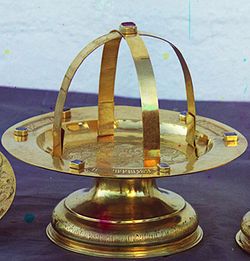
The priest holds the asterisk over the incense, kisses it, and then places it on the Diskos, saying: “The star stopped over the place where the Child was.”82
Then the priest goes on to recite the ancient prophecies concerning Christ’s divinity, for the human Child was also “Immanuel,” meaning, “God With Us.”83 The priest then says, “At the word of the Lord the heavens were established.84 The Lord reigned, clothed in beauty,85" and, “His virtue covers the heavens and the earth is full of His understanding.”86 While he is saying this, the priest covers the Diskos and the Chalice with fine veils and censes them on all sides. In like manner was the Incarnate God veiled till the heavenly witness of the Father and the Holy Spirit (in the form of a dove) at His baptism in the Jordan.
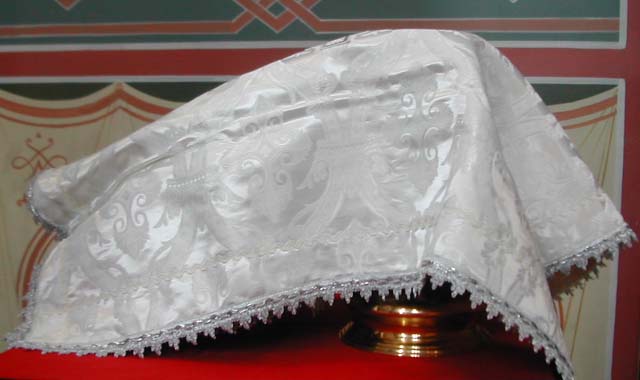
The priest holds the veil for the Diskos over the incense, kisses it and then places it over the asterisk, reciting Psalm 93:1: “The Lord is King, He is robed in majesty; the Lord is robed in beauty, and He is girded with strength. For He established the world; it shall never be shaken.” The priest holds the veil for the Chalice over the incense, kisses it, and then places it over the Chalice, quoting the prophet Habakkuk: “Your power covered the heavens, O Christ, and the earth is full of Your praise.”87 he priest holds the aer over the incense, kisses it, and then places it over the gifts, saying: “Shelter us, O God, in the shelter of Your wings;88 drive away from us every enemy and foe; make our life peaceful; O Lord, have mercy on us and on Your world, and save our souls, for You are good and You love humanity, and are a merciful God.”
The priest takes the censer and censes the gifts, saying thrice: “Blessed is our God who is thus pleased:89 Glory to You.” Then the priest says: “O God, our God, who sent forth the heavenly Bread, the Food to the whole world,90 our Lord and God Jesus Christ, our Savior and Redeemer and Benefactor, blessing and sanctifying us: Bless this oblation, and receive it upon Your most heavenly altar. Remember, as You are good and love humanity, those who brought this offering and those for whom they brought it. Preserve us blameless in the celebration of Your divine mysteries; for sanctified and glorified is Your most honorable and majestic name, of the Father and of the Son and of the Holy Spirit, now and ever, and to the ages of ages.”
The priest makes three metanias before the
Prothesis, and then kisses the Diskos, the Chalice, and the cross on the aer,
saying:
“Holy God: the unoriginate Father (the priest kisses the Diskos);
“Holy Mighty: the co-eternal Son (the priest kisses the Chalice);
“Holy Immortal: the all-holy Spirit (the priest kisses the cross on the aer);
“O Holy Trinity: Glory to You."
The priest then says the dismissal of the Proskomide.
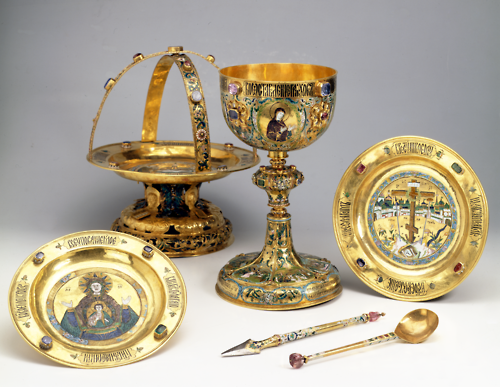
 ==========================
==========================
44 This is not to suggest, however, that a valid Eucharist couldn’t be offered using unleavened bread. 45 Cf. Galatians 4:4; Ephesians 1:10.
46 Germanus of Constantinople, On the Divine Liturgy, 38-39. 47 Hebrews 4:15.
48 John 6:51.
49 Galatians 3:13. 50 Revelation 17:14.
51 Isaiah 53:7.
52 Cf. John 13:1; 19:14, 31, 42.
53 Isaiah 53:8 (LXX). 54 John 16:28.
55 John 1:29.
56 John 6:51.
57 John 19:34-35.
58 1 Corinthians 10:16-17.
59 Hebrews 12:23.
60 Romans 12:1.
61 Psalm 45:9.
62 Ephesians 2:20.
63 Jude 3.
64 Song of Songs 8:6.
65 Ephesians 6:11-17. 66 In this regard, it is instructive to hear what the third bishop of Antioch after the apostle Peter, Saint Ignatius (martyred A.D.110), has to say on the subject. As he was being led to his martyrdom in Rome, he wrote to the church in Magnesia: “For, just as there are two coinages (cf. Matt 22:19-21), the one of God, the other of the world, and each has its own stamp impressed on it, so the unbelievers bear the stamp of this world, and the believers the stamp of God the Father in love through Jesus Christ, and unless we willingly choose to die after the likeness of His Passion, His life is not in us” (Epistle to the Magnesians, 5:1).
67 Colossians 1:24.
68 Cf. Luke 2:25ff.
69 Or Basil the Great, archbishop of Caesarea, if the Liturgy of Saint Basil is celebrated.
70 If there is to be a Hierarchical Divine Liturgy, the priest now covers the Diskos and Chalice with the aer, leaving the prothesis
for the bishop to complete the Proskomidia. 71 2 Timothy 2:15. 72 If other priests are concelebrating, they may now approach the prothesis, make three metanias, reverence the prothesis, take up the spear and remember whom they desire of the living and the departed. 73 Ephesians 5:2.
74 Colossians 2:9.
75 Exodus 30:1-10, 34-38; 37:25-29.
76 The Ark was a rectangular box made of acacia wood covered with gold and topped by two cherubim (angels) overlooking the
“mercy seat” between them. The Ark contained the tablets on which were inscribed the Ten Commandments, a jar of manna, and
Aaron’s rod (Cf. Hebrews 9:4).
77 Luke 1:9-11.
78 Leviticus 16:12-13. 79 Flavius Josephus, Antiquities of the Jews, 9:10:4.
80 Revelation 5:8; 8:3-4.
81 Matthew 2:9. 82 Ibid.
83 Isaiah 7:14.
84 Psalm 33:6.
85 Psalm 93:1.
86 Cf. Habakkuk 3:3. 87 Ibid.
88 Psalm 17:8.
89 Cf. Isaiah 42:21.
90 Psalm 136:25